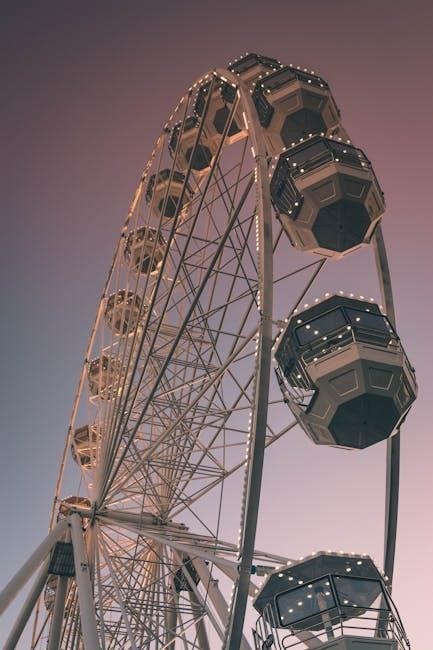Proper sizing of outdoor lighting enhances curb appeal, ensures safety, and balances functionality with aesthetic appeal. This guide helps you choose the right fixtures for your space, addressing key considerations like brightness, energy efficiency, and design harmony to create an inviting and functional outdoor environment.
1.1 Importance of Proper Sizing for Outdoor Lighting
Proper sizing ensures functionality, safety, and aesthetic appeal. Oversized fixtures can overwhelm spaces, while undersized ones may fail to provide adequate illumination. Correct sizing balances light distribution, energy efficiency, and visual harmony, enhancing curb appeal and creating a welcoming exterior environment. It also prevents excessive glare and ensures durability, making it a critical factor in outdoor lighting design and functionality.
1.2 Overview of Key Factors in Outdoor Lighting
When selecting outdoor lighting, consider space dimensions, fixture type, brightness needs, energy efficiency, and design compatibility. Understanding these factors helps in choosing the right size and style, ensuring optimal illumination and aesthetic harmony. Proper planning and measurement are essential to achieve functionality and visual appeal in your outdoor spaces, creating a balanced and inviting environment tailored to your specific needs and preferences.

Understanding Different Types of Outdoor Lighting
Outdoor lighting includes wall-mounted, post-mounted, and freestanding options, each serving unique purposes. Understanding these types helps in selecting fixtures that complement your space and meet specific needs.
2.1 Wall-Mounted Outdoor Lighting
Wall-mounted outdoor lighting is a versatile option, ideal for enhancing security and ambiance; It comes in various styles, from modern to traditional, and can be placed near doors, garages, or along walkways. When selecting, consider the fixture’s size relative to the wall and door proportions. Energy-efficient LED options are popular, offering durability and long lifespan. Ensure the design complements your home’s exterior for a cohesive look.
2.2 Post-Mounted and Freestanding Outdoor Lighting
Post-mounted and freestanding lights are perfect for illuminating large areas like driveways or yards. They often serve as statement pieces, combining functionality with style. These lights are typically taller and broader to cover more ground. Solar-powered options are eco-friendly and cost-effective. Choose sizes that align with your space’s scale, ensuring adequate light coverage without overwhelming the landscape. Durability is key for withstanding outdoor elements.

How to Measure Your Space for Outdoor Lighting
Begin by assessing the dimensions of your porch, patio, or yard using a tape measure. Identify key areas needing illumination, such as pathways or seating areas. Sketch a layout to visualize light placement. Measure length and width for rectangular spaces and diameter for circular areas. Note power source locations and check local regulations. Create a shopping list based on your measurements and layout to ensure accurate purchases.
3.1 Measuring Your Porch, Patio, or Yard
Start by measuring the length, width, and height of your outdoor space. Use a tape measure to assess the dimensions of your porch, patio, or yard. Identify key areas, such as pathways, stairs, or seating spots, that require lighting. Sketch a basic layout to visualize where fixtures will be placed. Measure the distance between power sources and potential mounting points. Record these measurements to guide your fixture selection and installation planning.
3.2 Calculating the Ideal Light Fixture Size
To determine the ideal size, consider the space’s purpose and dimensions. For security, larger fixtures may be needed, while decorative lights can be smaller. Use lumens as a guide: 2,700–3,699 lumens for smaller areas and 4,500–5,499 lumens for larger spaces; Balance functionality with aesthetics to avoid bulky fixtures. Check manufacturer guidelines for specific sizing recommendations to ensure the fixture fits both the space and desired style.

Lighting Needs Based on Purpose
Outdoor lighting needs vary by purpose, with security requiring bright, wide coverage and decorative lighting focusing on style and subtle illumination. Energy efficiency is key in both cases.
4.1 Security Lighting Requirements
Security lighting requires bright, wide coverage to deter intruders and enhance visibility. Fixtures should be placed strategically near entry points and dark areas. High-intensity lights with motion sensors are ideal for alerting homeowners to movement. Energy-efficient options like LED lights are recommended for durability and long-lasting performance. Proper placement ensures safety without causing glare or light pollution, maintaining both functionality and aesthetic appeal effectively.
4.2 Ambient and Decorative Lighting Size Recommendations
Ambient and decorative lighting should balance style and functionality. Fixtures like lanterns or sconces should be scaled to the size of your porch, patio, or yard. For pathways, smaller, subdued lights work best, while larger spaces may require wider coverage. Consider brightness levels between 200-800 lumens for soft illumination. Choose designs that complement your home’s exterior, ensuring harmony between size and aesthetic appeal for a cohesive look.

Lumens and Wattage: A Guide to Brightness
Lumens measure brightness, while wattage indicates energy use. For outdoor lighting, higher lumens provide more light, but lower wattage saves energy. Choose fixtures with balanced lumens and wattage for optimal brightness and efficiency, ensuring your space is well-lit without excessive power consumption.

5.1 Understanding Lumens for Outdoor Spaces
Lumens measure light intensity, crucial for outdoor spaces. Higher lumens mean brighter light, essential for larger areas or security. The Japan Lighting Manufacturers Association recommends 2,700–3,699 lumens for 9.2m spaces and 4,500–5,499 lumens for 18.4m areas. Understanding lumens ensures proper illumination, balancing brightness and energy efficiency for desired ambiance and functionality in your outdoor setup.
5.2 Wattage and Energy Efficiency in Outdoor Lighting
Wattage indicates energy consumption, while lumens measure brightness. Higher wattage doesn’t always mean more light; efficient options like LEDs provide high lumens with lower energy use. Look for Energy Star-rated fixtures to reduce power consumption without compromising brightness. Balancing wattage and lumens ensures bright, energy-efficient outdoor lighting solutions that lower utility bills and environmental impact while maintaining desired light levels for safety and aesthetics.
Manufacturer Guidelines for Outdoor Lighting
Manufacturers often provide specific sizing recommendations for outdoor lighting fixtures. The Japan Lighting Manufacturers Association suggests 2,700-3,699 lumens for 9.2m spaces and 4,500-5,499 lumens for 18.4m spaces.
6.1 Standard Sizes for Outdoor Light Fixtures
Outdoor light fixtures come in standard sizes to suit various spaces. Typical diameters range from 8 to 24 inches, with heights varying from 10 to 36 inches. Lumens guide brightness, with 2,700-3,699 recommended for smaller areas (9.2m) and 4,500-5,499 for larger spaces (18.4m). These measurements ensure balanced lighting and aesthetic consistency, helping homeowners choose fixtures that align with their environment and needs while adhering to manufacturer guidelines.
6.2 Brand-Specific Recommendations
Different brands offer tailored sizing guidelines for their outdoor lighting fixtures. For example, Lumena Lights provides specific charts for path lights, porch lights, and post-mounted fixtures. Brands often recommend sizes based on fixture type and intended use, ensuring optimal performance and design harmony. Checking manufacturer guidelines helps homeowners select fixtures that meet both functional and aesthetic needs for their unique spaces.

Styling and Design Considerations
Outdoor lighting should complement your home’s architecture and landscape. Consider fixture styles, materials, and finishes to ensure design harmony. Choose designs that blend functionality with aesthetic appeal for a cohesive look.
7.1 Choosing the Right Style for Your Home
Selecting the right outdoor lighting style involves matching your home’s architecture and personal taste. Modern, traditional, rustic, or coastal designs offer diverse options. For sleek, contemporary looks, opt for minimalist fixtures, while ornate designs suit classic homes. Consider materials like brass, wrought iron, or aluminum for durability and aesthetic appeal. Ensure the style aligns with your home’s exterior to create a cohesive and inviting ambiance.
7.2 Balancing Size and Aesthetic Appeal
Balancing size and style ensures outdoor lighting complements your home’s design without overwhelming it. Scale fixtures to match your home’s proportions, avoiding oversized or undersized units. Consider the fixture’s height, width, and design elements like finish and shape. Harmonizing size with aesthetic appeal creates a visually pleasing exterior that enhances both functionality and curb appeal effectively.

Local Regulations and Compliance
Outdoor lighting must comply with local ordinances to avoid fines and ensure safety. Regulations often address light pollution, brightness levels, and placement to maintain community standards and neighbor comfort.
8.1 Understanding Local Lighting Ordinances
Local lighting ordinances vary by region and dictate standards for brightness, light pollution, and fixture placement. These regulations aim to preserve neighborhood aesthetics and minimize light trespass. Compliance ensures harmony and avoids penalties. Researching and adhering to these guidelines is crucial for a hassle-free installation, ensuring your outdoor lighting setup aligns with community standards while maintaining functionality and visual appeal effectively always.
8.2 Ensuring Compliance with Size and Placement
Precise measurements and adherence to manufacturer guidelines are key to compliant outdoor lighting. Size and placement must align with local codes, ensuring functionality and aesthetics. Regular inspections and seasonal adjustments, like trimming foliage, maintain compliance. Always verify fixture dimensions and positions with ordinances to avoid violations and ensure your lighting enhances both safety and curb appeal effectively year-round.

Maintenance and Upkeep Tips
Regular cleaning prevents dirt buildup, ensuring optimal light output. Replace faulty bulbs or fixtures promptly to maintain functionality and safety.
Inspect wiring for damage and tighten connections. Adjust fixtures seasonally to accommodate foliage or weather changes, ensuring consistent lighting performance.
9;1 Cleaning and Replacing Outdoor Light Fixtures
Regularly clean outdoor light fixtures with a soft cloth and mild detergent to prevent dirt buildup. Replace damaged or worn-out bulbs promptly. Check compatibility when replacing fixtures to ensure proper fit and function. Inspect wiring for signs of wear and tighten connections. Seasonal adjustments may be needed to accommodate foliage or weather changes, ensuring optimal performance year-round.
9.2 Adjusting Lighting Size for Seasonal Changes
Seasonal changes may require adjusting outdoor lighting size to accommodate foliage or weather conditions. For example, larger fixtures can handle winter debris, while smaller ones suit summer minimalism. Swapping fixtures or adjusting brightness ensures optimal performance. Consider timers or smart controls to adapt lighting needs automatically, maintaining functionality and curb appeal throughout the year. This ensures your lighting remains efficient and visually appealing;
Selecting the right outdoor lighting size ensures functionality, safety, and aesthetic appeal. Use this guide to make informed decisions, enhancing your space with confidence and precision.
10.1 Final Tips for Choosing the Right Outdoor Lighting Size
Measure your space accurately, consider lighting purpose, and balance size with style. Check lumens and wattage for brightness needs, cross-reference manufacturer guidelines, and ensure compliance with local regulations for optimal results and aesthetic appeal. Proper sizing enhances functionality, safety, and curb appeal, making your outdoor space inviting and well-lit.
10.2 Resources for Further Reading
For deeper insights, explore guides from manufacturers like Lumena Lights, industry reports from lighting associations, and design blogs. Websites offering lumens calculators and style tips can also aid decision-making. Additionally, local hardware stores and lighting experts provide personalized advice, ensuring your outdoor lighting choices are both functional and visually appealing. These resources help refine your approach to outdoor lighting design and sizing effectively.
